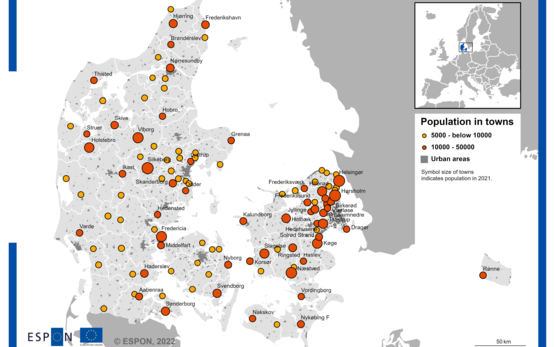Spotlight
-

Denmark, small and medium sized cities
Case Studies | August 25, 2022Looking for new activities and attractions to maintain vibrant town centres and develop appealing urban areas

Looking for new activities and attractions to maintain vibrant town centres and develop appealing urban areas

This report contributes to the Maritime Spatial Planning with two objectives: to undertake an analysis and characterization of the coastal and maritime planning and land-sea interactions from a mul

Article 174 of the TFEU states that: '’the Union shall aim at reducing disparities between the levels of development of the various regions and the backwardness of the least favoured regions.

This project, emanating from the targeted analysis project Maritime Spatial Planning and Land Sea Interactions (MSP-LSI) explores the potential spatial tensions between the deployment of renewable sources of blue energy (energy derived from our seas and oceans), with a particular focus on offshore wind energy, and other (potential) utilisations of the European seas.

This study analyses the implementation of an Integrated Territorial Investment (ITI) targeting small islands of the North Aegean Region in the 2014-2020 programming period, considering observed pat

ESPON has published an Atlas to analyse the territorial dimension of the Europe 2020 Strategy and to present the regional and, when possible, urban dimension of Smart, Sustainable and Inclusive Growth as defined in the Strategy.

Territorial Cooperation Programmes play an important role for the development of Europe. Programme investments enable the mobilization of under-used territorial potentials, contributing to the competitiveness of Europe and to the necessary economic growth and job creation.

The Territorial Agenda 2020 highlights that Europe faces challenges with regard to aging and depopulation in several regions including rural and peripheral ones. On growth and social cohesion the Europe 2020 objective of inclusive growth is asking at the same time for the implementation of policies to promote gender equality and to increase labour force participation. Hence, gender imbalances are not only an issue for gender politics. They are both an effect of territorial developments and structures, and a condition for future growth of regions having an impact on social and territorial cohesion.

The ESPON TerrEvi – Territorial Evidence Packs for Structural Funds Programmes - project focuses on producing evidence for Structural Funds programmes with the aim to support the development of the programmes to be carried out in the 2014-2020 period.

The attractiveness of Europe and its regions and cities is a theme of the Europe 2020 strategy and Territorial Agenda. Territorial assets and the quality of places are important dimensions of many regional development strategies within a globalising and interconnected world. Competition has intensified and financial resources become increasingly footloose. Consequently the capacity to attract these footloose resources that include human capital has become an increasingly important aspect of regional development.

With the publication Territorial Observation No. 6, focusing on “Territorial Dynamics in Europe: Regions and cities in the global economy”, ESPON offers evidence, maps and points for policy consideration related to regions and cities in the global economy.

The sixth volume of ESPON Territorial Observations focuses on Regions and cities in the global economy.

Climate change is a high profile political issue in Europe. Scientific evidence and explanations of climate change have accumulated over several decades. The coordinated work of the Intergovernmental Panel on Climate Change (IPCC) and the first obvious signs of climate change moved the topic into general public debate and onto the political agenda.

The fifth volume of ESPON Territorial Observations focuses on Creative Workforce. Regions with high concentrations of creative and cultural industries have Europe’s highest prosperity levels. Evidence suggests that jobs and growth follow these creative people as much as creative people follow jobs and growth, and attractive places.

The first number of ESPON Territorial Observation aims at giving policy makers and practitioners short and concise information on important new evidence related to dynamics of population development and migration in Europe and its regions.

The second number of ESPON Territorial Observations aims at providing policy makers and practitioners with short and concise information on important new evidence related to dynamics of accessibility development in Europe and its regions.

ESPON Territorial Observations aim at providing policy makers and practitioners short and concise information on territorial dynamics. The third volume put focus on territorial aspects of the Lisbon and the Europe 2020 strategies by comparing the position and trends of regions around Europe on related indicators.